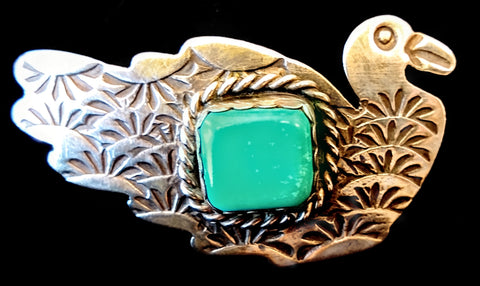
Navajo Sterling Silver, Copper, Turquoise, Red-Goldstone, and Coin Necklace by Betty Yellowhorse (SOLD)
$ 500.00
Native American Navajo Sterling Silver necklace by Betty Yellowhorse - $500
NECKLACE:
19-1/2" L -- Necklace without pendant (open)
9-1/2" L -- Necklace without pendant (closed)
13-1/2" L -- Necklace with pendant (closed)
4" L x 1-1/4" W -- Pendant
CLASP: Lobster claw clasp
CONDITION: Vintage, Never Worn
A stunning turquoise stone is featured in the pendant with a smaller matching stone underneath. The pendant is finished with three dangling Indian Head pennies dated 1904, 1905, and 1907. The bezel setting of this pendant is a unique marriage of silver and copper, and the bail is an artistic, handmade spiral design in copper. The pendant hangs from a string of round red-goldstone beads and turquoise nuggets strung on wire. The red-goldstone beads reflect the rich copper color of the pennies and handmade findings. The blend of copper coloring with turquoise creates a warm, autumnal palette, and the turquoise beads are shot through with copper colored veining, bringing the color scheme together in beautiful harmony. The back of this necklace bears Yellowhorse's hallmark proving its authenticity.
Betty Yellowhorse is an accomplished silver smith, working in the rich Navajo tradition. She is known for incorporating beautiful old coins into her jewelry. Working with silver coins in jewelry is a practice which points to a time before the use of sheet silver and bezel wire, and so coin work taps the deepest roots of tradition in Navajo silver jewelry making. Betty Yellowhorse jewelry is imbued with the richness and beauty of this lineage, not only through traditional techniques and designs, but also by incorporating the long history held in such old coins.
The Indian Head one cent coin has a long, interesting history. Through its run from 1859 through 1909 it underwent changes in size, design, and metal content. Through the American Civil War and after, it saw phases of being hoarded and at other times circulated freely. Many of these coins were used in the earliest coin operated machines, referred to as penny arcades.
Because these items are hand-crafted by local artisans using traditional techniques, slight variations may occur. Note that colors may vary according to each display monitor.




















